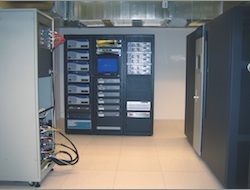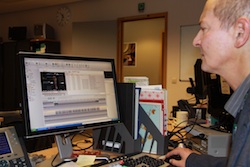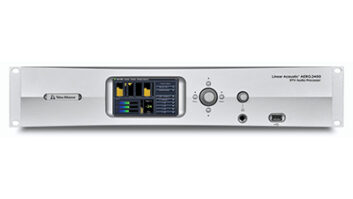
The European Parliament Audiovisual Unit’s Migration move to a unique central digital archive has been shortlisted for the 2010 IBC Innovation Awards – with the winner to be announced in Amsterdam. Here, TVBEurope presents the background to this milestone European content management project.
The European Parliament (EP) has been a directly elected institution of the European Union since 1979. It is one of the world’s most powerful legislatures. Besides providing broadcasting services on an internal cable television network, the European Parliament’s audiovisual unit provides video streaming to the web and publication to FTP servers, and transmission to Europe by Satellite (EBS), the news exchange networks, and selected television channels.
The mission of the EP Audiovisual Unit thus is integral to the core democratic mission of the Parliament itself, ensuring that the electorate to whom the Parliament is responsible can see and study the record of the decision-making process.
In turn, a fundamental element of the audiovisual unit’s mission is to oversee the EP’s media archive, which is maintained for the legal and historical record as well as for the use of members of parliament, journalists, and scholars. While the EP assumed its present form in 1979, its roots stretch all the way back to 1952. In the Parliament’s more than half century of existence, its archive has amassed a unique audiovisual collection that chronicles a significant part of both European and world history.
In 2008, the EP recognised that the addition of a new building, D5, to their operation created a unique opportunity for the timely implementation of a centralised digital archive storage system. As far as is known, the EP’s centralised digital archive is today both the first in Europe to include an integrated end-to-end system for migrating analogue content into the fully managed digital realm and the first of its kind implemented with the express purpose of ensuring governmental transparency.
Implementation of the centralised digital archive storage system was intended to serve multiple purposes. Because the collection had been accumulated over time, it was stored in multiple formats. Thus, one of the D5 project’s goals was to migrate that content into a uniform and readily accessible format.
At the time the project was initiated, some of the archival content was already stored in digital format — on a Sony data tape system. However, most of the content was still stored in analogue format, on Digital Betacam videotapes. A still smaller percentage remained on Betacam SP videotape while some was on very old analogue videotape and vinyl.
Archivists had for a long time recognised that the lack of consistency in storage formats created headaches anytime they sought to find, identify, or retrieve and use specific content. Of course, content that cannot be accessed might as well be lost for good. A further problem was that videotape’s shelf life is limited, with time inevitably leading to its deterioration. As a result, preservation of some irreplaceable, historic content in the European Parliament archive was in jeopardy.
DIVA to Harris
Implemented by the EP audiovisual unit and the professional team from Luxembourg-based Broadcasting Centre Europe (BCE), the D5 centralised digital archive project rectifies these issues by integrating all content into a coherent, unified system based on a Sun StorageTek data tape library complemented by near line storage from Isilon connecting to Grass Valley K2 video servers. The system as a whole is unified through the use of a much expanded and upgraded Front Porch Digital DIVArchive content storage management system.
To overcome the challenges specifically related to access, the EP audiovisual unit also implemented Front Porch Digital’s DIVAdirector application as an integral part of the centralised archive. Running in combination with DIVArchive and a Harris T-Rex MAM system, DIVAdirector is enabling the cataloguing and tracking of archived media assets, allowing 16 European Parliament editorial staff archivists to browse content in the form of automatically generated low-bit-rate proxies, to create frame-accurate shot lists, and to use customisable metadata to find and identify specific media using query tools. In contrast to a videotape archive, the centralised digital system supports the archivists’ efficiency by enabling them to enjoy simultaneous, high-speed access to content.
An integrated hardware and software solution, DIVAdirector features mirrored system disks and RAID 5 storage for Windows Media 9 proxies. Because DIVAdirector can import legacy databases of virtual assets, such as those still stored on videotape — along with their associated metadata field mapping — it makes it possible for the EP to track even content that has not yet been digitised. Once file-based content and proxies have been ingested, DIVAdirector automatically links them to their appropriate virtual assets. Thus, the system enables consolidation of comprehensive data on all EP’s media collection via a single interface.
The archive itself is modular and consists of a robotised library, which supports the MXF digital file format, stored on a long-life LTO4-type IT support. In its final configuration, the archive’s storage capacity will be 340 TB (15,000 h at 50 Mbps), with 900 cartridge slots, 10 recording and reading machines, a loading speed of less than 30 seconds per cartridge, and access speed to a single cartridge file of 90 seconds or less.
Because a fundamental project goal was preserving the historic record, a key component has been migration of some 12,000 hours of EP’s legacy media content from storage on videotape into the managed digital environment — a process that was completed on time in January 2010. To accomplish this, the EP audiovisual unit and BCE deployed six Front Porch Digital SAMMA Solo systems arrayed in a set-up with legacy VTRs and interfaced to an existing Sony FlexiCart system.
Record of Parliament
Because EP had set the goal of completing the migration as early as possible in 2010, it was necessary to find the most efficient possible system for accomplishing it. The SAMMA Solo is a semi-automated system that performs realtime, simultaneous encoding of content from videotape into multiple digital files then manages their ingest into the digital workflow.
With the migration component, EP’s centralised archive has accomplished a first in the annals of European media organisations — an integrated end-to-end system that moves legacy analogue video content into a comprehensively managed digital structure. Under the direction of experienced BCE staff and services, the SAMMA Solo systems met the target of complete migration of the 12,000-hour videotape archive to digital formats by January.
According to the EP audiovisual unit’s staff, the centralised digital storage system has given their archivists access to a broader spectrum of the archive’s collection than they ever had before. This supports one of its core missions, to make the record of Parliament — and in fact of Europe over more than 50 years of its history — available to the media.
As a result of this project, some of the content is being made available for the first time. Just as important, the project ensures preservation of this record for future generations. Working with BCE to devise an innovative combination of best of breed technologies, EP has been able to maximise resources while creating a centralised storage system that meets its needs and serves the public.







